- Home
- Gary Vaynerchuk
The Thank You Economy Page 4
The Thank You Economy Read online
Page 4
Now explain this to me: if you care enough about your brand to react with this kind of interest and concern were you to overhear this conversation in person, why wouldn’t you respond similarly if you read these same comments online? If there are conversations about your brand or your product or service category happening in coffee shops and beauty parlors and subways, they are most likely also happening on Facebook and Twitter and on all sorts of popular blogs and forums, and you can “hear” them all. These conversations were always happening before the advent of social media, of course, but there was only so far they could go. In addition, all a business could do if it became aware of these conversations was to eavesdrop. Now the talk and word of mouth about your company or brand can go on indefinitely, but you have a tremendous advantage the businesspeople before you didn’t have: you and your entire team can participate in and propagate it. To ignore that option is to become a lonely fly on the wall—witness to everything that is said about you, powerless to do anything about it. All you’re setting yourself up for is a face-to-face with a flyswatter.
Get on Board
If you’re an entrepreneur, you surely already know I’m telling the truth because if you’re having any success, it’s extremely likely you’re already engaging with your customers online and offline with equal intensity and enthusiasm. I hope my ideas and the examples in this book will inspire you to take your business to the next level, and give you ways to help others trying to make it.
If you want to become CEO one day, you absolutely have to get on board this train. Bringing about a massive cultural shift within a company takes a lot of time and finesse if you’re going to do it well. You’ll likely be competing against others who have been incorporating TYE principles into every aspect of how they do business from the day they opened their first Twitter account. The person who gets started the soonest has the advantage, though not because of the number of fans and followers they may have. I’m not sure what those people who promise to donate a thousand bucks to Haiti (if they can get a hundred people to follow them on Twitter) think they’re accomplishing. Just give the thousand bucks to Haiti, you jerks! It’s not the number of followers you have or “likes” you get, it’s the strength of your bond with your followers that indicates how much anyone cares about what you have to say. In this game, the one with the most real relationships wins.
Mid-level managers who love what they do and want their company to compete and thrive and crush it have got to get this book onto their CEO’s desk. Individuals can certainly adapt many of the lessons in this book to buff their own personal brand and even improve the way their department communicates and responds to the people and organizations with which they do business. But for a whole company to successfully enter the Thank You Economy, many small, practical steps and processes must be implemented that ultimately add up and result in a complete cultural transformation. Each baby step is easy to take, but only a total commitment to change over time from the top brass will ensure that the baby steps gain enough strength and speed to lead into a run. Unfortunately, many CEOs are afraid of implementing change, even when it’s for the best long-term good of the company. That sounds harsh, but it’s unfortunately true, and for good reason. I’m convinced that if company leaders didn’t have to worry about stock prices or bonuses or their numbers, every one of them would be investing in social media by now. It just makes sense that the better you know your consumers, the better you can tailor your marketing to them, and the more likely they are to buy from you. But many leaders can’t afford to worry about the long term, because their survival (and their bonus) depends on short-term results.
On a recent flight, I read an article by an editor-at-large for the Harvard Business Review (I know, I know, Mr. “I don’t read anything” reads stuff from the HBR…insert your one-liner about me here) that perfectly crystallized the dilemma faced by even the most well-meaning CEOs: “Wall Street Is No Friend to Radical Innovation.” The article reported the results of a study from the Wharton School that found that even when it was clear that an industry was about to be rocked by massive changes, Wall Street analysts primarily gave a thumbs-up to company strategies that relied on old technology, and seemed to ignore or minimize the validity of more daring attempts to take advantage of new technology. Wall Street puts CEOs in a near impossible situation, as described by Chris Trimble, on the faculty at Tuck School of Business at Dartmouth: “I’ve had CEOs tell me that ignoring Wall Street is the only way to do the right thing for the company’s long-term future. They choose to invest in innovation, take the short-term punishment (in the form of a declining stock price), and hope that the punishment is not so severe that they lose their job.” So what are people trying to convince their CEO that social media matters supposed to do when the metrics that they need to justify social media initiatives just aren’t available yet?
Start. If you already have started, take a second look at what you’re doing. Try on a new pair of glasses and reevaluate. Be prepared. Stay alert to new ideas and innovations. Do whatever you can to bring the Thank You Economy sensibility into your company, so that when you’re finally able to implement initiatives, the foundation will already be set.
Companies can certainly survive without social media. Maybe your competitors can afford to (over)spend on traditional platforms, or have a lot of brand equity built up thanks to amazing content. But if they do nothing with social media, and you do something, you will eventually have the potential to surpass them, not thanks to any one platform—and not overnight; it’s a marathon, not a sprint—but because you acknowledge that culture and consumer expectations can and will change. That in and of itself means that you are more adaptable and flexible, and therefore have a better chance of surviving and flourishing in the Thank You Economy.
One more time: if you succeed with social media, it won’t be because of the platform; it will be because you acknowledge that culture and consumer expectations can change. You are more adaptable and flexible than your competitors. If you apply social media correctly, your customers will buy more, they will be more loyal, they will spread your message, and they will defend you should you ever need them to. All of this adds up to your increased chance of surviving and flourishing in the Thank You Economy.
You know the business world has changed. You can feel it, can’t you? Go to a shopping mall, a movie theater, a stadium, and look at what the masses are doing. For better or for worse, half if not more of the people are walking around with their heads down, their fingers sliding and tapping over their handheld devices.
* * *
Though girls ages fourteen to seventeen can still out-text anyone, averaging about a hundred texts per day compared to boys of the same age, who text about thirty times per day, texting isn’t just for kids anymore. As of May 2010, 72 percent of the adult population were texting, at a rate of about ten texts per day. What do you think the number will look like by 2013?
* * *
When they’re home, they’ve got those same handheld devices at their side, plus they’re glued to their iPads and computers. Most of them are not just reading AOL’s homepage anymore, I guarantee you. They’re engaging with the content and their friends on Facebook and Twitter and Foursquare, Digg and Reddit, and a slew of websites you’ve probably never heard of. So why are you buying banner ads on AOL.com or Yahoo.com? Many of the brands that were relevant even five years ago no longer command respect or excitement because they’ve lost touch with their customers by continuing to talk to them almost exclusively via traditional marketing platforms. The customers aren’t there in nearly the numbers they once were. They’re on social media; you need to follow them, and talk to them, there. If you wait for your competitors to do this, and they do it right, they will steal any advantage you might have had right from under your nose.
For example, Zagat was the original consumer review destination, the “burgundy bible” for foodies, a twenty-year-old golden brand that never should have had to fight for relev
ance or survival. Yet because it was so slow to recognize that customer expectations and desires were changing, the company has had to roll up its sleeves and start swinging to defend itself. Zagat’s story is a great example of how resistance to change and poor anticipation skills can hurt a giant in an industry. On the other hand, they’re also an example of how companies can make a comeback once they figure out how to harness the innovation they once fumbled. To get a feel for the battle they’ve been waging, all you have to do is compare their timeline with those of one of their biggest competitors, Yelp.
1979: The Zagats hit upon the idea of collecting opinions from their friends and their friends’ friends of New York City restaurants to create an informal yet reliable restaurant guide. Over the next two decades, The Zagat Review becomes an internationally recognized force in the culinary world, with over 100,000 contributing surveyors and a loyal readership.
1999: Zagat launches its website, but only paid subscribers can read full reviews.
2004: Former PayPal employees Jeremy Stoppelman and Russel Simmons launch Yelp from a San Francisco Mission Street office. The decidedly hip site offers free access to user reviews of restaurants, day spas, and other local businesses.
2007: Yelp reports five million unique visitors.
January 2008: The Zagats try to sell their business for $200 million. There are no takers.
May 2008: Yelp reports ten million unique visitors.
June 2008: The Zagats take the business off the market.
July 2008: Yelp releases the Yelp for iPhone app. The application is free.
November 2008: Zagat releases the Zagat to Go iPhone app. It costs $10.
July 2009: Zagat holds steady as one of the top ten iPhone apps in the travel category.
August 2009: Yelp, which is still free, reports over 25 million unique visitors.
September 2009: Zagat.com, which charges a $25 annual membership fee, gets about 270,000 unique visitors per month, and is “trending downward.”
December 2009: Yelp turns down a $550 million offer from Google, and a $700 million offer from Microsoft. “Yelp has the chance to become one of the great Internet brands,” says Stoppelman. “That for me is the chance of a lifetime.”
January 2010: Modeling Foursquare, Yelp adds a “check in” feature to its app upgrade.
February 2010: Zagat teams up with Foursquare. Foursquare users can earn a “Foodie” badge when they check in to Zagat-rated restaurants, and receive menu recommendations from the Zagat collection of reviews.
August 2010: Zagat is ranked the most-followed brand on Foursquare by Osnapz, with 65,000 followers.
August 2010: Zagat integrates Foodspotting, which allows people to post photos and comment about the foods they love rather than read and write full-blown reviews, into the Zagat To Go app.
If Zagat had kept an eye on the innovation horizon, Yelp never would have been able to cut into their market share in the first place. Yet as you can see, Zagat has swung hard and gotten in a few good hits. It is possible for brands, websites, and new businesses to take market share from sleeping giants, and even become market leaders, but if the sleeping giant awakens and uses the brand equity it has created over the years, it can absolutely get back in the game. This is good news for any larger organization that is only now recognizing that it needs to make social media a priority. Ideally, however, any giants who are awakening will adjust because they understand what is happening around them and want to adjust, not because, like Zagat, they have been backed into a corner and have no other choice.
It’s Not About Social Media
As I said in Crush It!,
Social Media = Business
The thing to keep in mind at all costs, though, is that the Thank You Economy is much, much bigger than social media. Social media’s arrival was simply the catalyst for a revolution that was already brewing in the minds of consumers sick to death of feeling isolated, unappreciated, and ignored. The Thank You Economy explains how businesses must learn to adapt their marketing strategies to take advantage of platforms that have completely transformed consumer culture and society as a whole. If this were 1923, this book would have been called Why Radio Is Going to Change the Game. If it were 1995, it would be Why Amazon Is Going to Take Over the Retailing World. I’m not proposing an all-or-nothing approach—there is still a place for brick-and-mortar businesses in a world where Amazon exists, and traditional media is still relevant and valuable. (Probably didn’t think I’d say that, huh? Wait till you read chapter five.) But there are too many businesses that are still holding back, watching the social media train rush by, convinced that if the destination is so great, another train will come along soon enough. They seem to think that it will be going more slowly, and the ride will be safe and steady, and they’ll be able to catch up with everyone else who jumped on early. They’re wrong, though. The next train, when it shows up, will be going full speed to some other equally exotic and unknown place. Social media is here to stay, but eventually, some technological innovation will be invented that will give intrepid travelers, the ones who understand that these trains of change are the only trains coming, another chance to move way ahead of the risk-averse. (I think anyone paying attention can see that mobile platforms are the next key to picking up market share…please tell me that you have a mobile strategy…) What will not change, however, is the culture—the expectation—of communication, transparency, and connection that social media revived. We live in a world where anyone with a computer can have an online presence and a voice; whatever follows next will simply make the power of word of mouth that much more powerful. The proliferation of blogs, with their invitation to comment, and the transparency of Facebook and Twitter, has marked an economic turning point. People thought they had seen a massive cultural shift when the public adopted the Internet into their daily lives, but the bigger shift occurred when the Internet began to allow for two-way conversation. Learn how to implement a culture of caring and communication into your business, scale your one-to-one relationships, and watch your customers reward your efforts by using their new and massively powerful word of mouth to market your business and your brand for you.
CHAPTER TWO
Erasing Lines in the Sand
In 1997, shortly after I launched WineLibrary.com, I was invited to a conference hosted by a local chapter of the New Jersey Chamber of Commerce to talk about online selling. It was my first speaking engagement, and I was pumped. I sat in the wings, trying to stay calm, as the speaker before me walked out onstage. He wore a tie. He had VP credentials and a fancy PowerPoint presentation. And the theme of his talk was that dotcom retail was a crock. It wasn’t practical, and it would never take off because, as the data on his PowerPoint slides revealed, nobody in Middle America was buying, nor would they ever buy, on the Internet. Mr. PowerPoint asked the audience, “How many of you have heard of Amazon?” A solid number of people raised their hands. He went on to ask if they really thought people would abandon the relationships they’d built over the years with their local bookstores, or even bypass super-stocked Barnes & Noble. They didn’t. It would be another two years before CEO Jeff Bezos would be named Time’s Person of the Year, his name underscored on the cover by the subhead “E-commerce is changing the way the world shops.” It would be another four years before Amazon reached its first quarterly net profit. Mr. PowerPoint compared the company’s rising market share to its nonexistent profits and said that one day we would all look back and say, “Remember Amazon?”
My short-term dream at the time was to become the Amazon for wine, and the audience I was about to explain that dream to was staring at this PowerPointing clown’s charts and graphs as if they were carved stone tablets brought down by Moses. As he finished up, he said, “This kid’s now going to tell you how he’s going to sell wine on the Internet. How many of you here would ever buy wine on the Internet?” Only one or two people out of sixty or seventy raised their hands.
You know if this had happened
in 2010, the talk would have been recorded and I could have posted it to show everyone what a jerk he was. But believe it or not, even though he called me a kid, he did earn my respect for calling me out. I like people with competitive spirit and bravado; they bring out the fight in me. Not that I won any battles that day. I walked out onstage and opened my talk by saying, “With all due respect to Mr. PowerPoint, he has no idea what he’s talking about. He is going to be on the wrong side of history. I feel bad for him.” I went on to tell my story, and gave my audience my best, most heartfelt argument as to why the Internet would be to retailers what the printing press was to writers. To the end, they remained a very skeptical, uninterested crowd.
Entrepreneurs have a sort of sixth sense that tells them when big change is afoot. The Time magazine article that accompanied Bezos’s Person of the Year award describes it best:
Every time a seismic shift takes place in our economy, there are people who feel the vibrations long before the rest of us do, vibrations so strong they demand action—action that can seem rash, even stupid. Ferry owner Cornelius Vanderbilt jumped ship when he saw the railroads coming. Thomas Watson Jr., overwhelmed by his sense that computers would be everywhere even when they were nowhere, bet his father’s office-machine company on it: IBM.
Jeffrey Preston Bezos had that same experience when he first peered into the maze of connected computers called the World Wide Web and realized that the future of retailing was glowing back at him.
Looking back, I can’t hold Mr. PowerPoint’s skepticism against him, nor can I blame the audience for dismissing most of what I had to say. Most people’s DNA simply doesn’t allow them an entrepreneur’s anticipation skills. They don’t see potential in the unknown, they see a threat to their comfort zone, so their knee-jerk reaction is to draw a deep line in the sand between themselves and anything new or unproven, especially when it comes to technology. Close to 90 percent of Americans own cell phones, but people my age can still remember when many questioned the need to be, and even the wisdom of being, reachable by phone at any time. Just four short years ago, we actually used those phones for talking, not texting. And no one was playing Farmville on Facebook.* How many of today’s more than 500 million Facebook users swore they’d never use the site?* There’s a reason the divide between innovators—people who eagerly embrace new technology—and the majority has been described as a chasm.

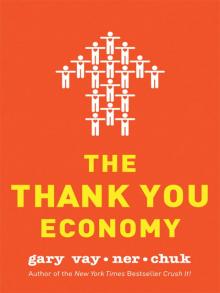 The Thank You Economy
The Thank You Economy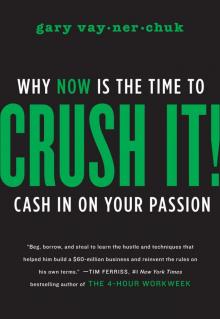 Crush It!
Crush It!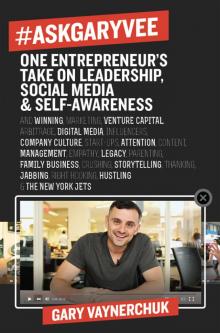 #AskGaryVee
#AskGaryVee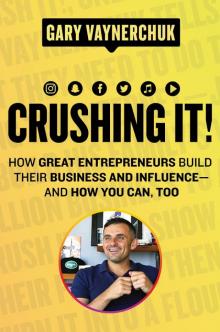 Crushing It! EPB
Crushing It! EPB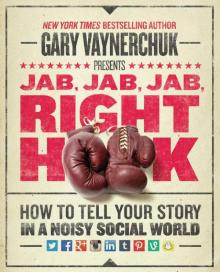 Jab, Jab, Jab, Right Hook
Jab, Jab, Jab, Right Hook